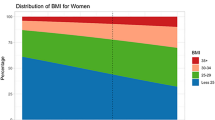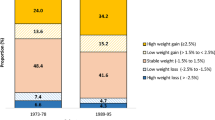Abstract
OBJECTIVE: This study examines three specific questions about obesity and overweight, using a nationally representative sample of Canadians. Are sociodemographic and lifestyle behaviors associated with body weight? Is body weight correlated with specific health outcomes? Has the prevalence of obesity in Canada changed since 1978?
METHODS: Secondary data analysis of a cross-sectional survey.
SAMPLE: This study uses the 1994 National Population Health Survey (NPHS) by Statistics Canada. It is a stratified random sample of 19 600 Canadians across all provinces.
RESULTS: The results show that age, gender, education, birth place and region, are significantly associated with obesity. When a lower criterion is used for overweight and obesity (body mass index, BMI≥25), dummy variables for marital status and occupation are also significant. Second, obesity is associated with poorer self-rated health, high blood pressure, heart disease, diabetes, arthritis, respiratory and stomach problems. For those respondents who have a BMI score ≥of 25 or greater, there is also an association with stroke. Finally, it is unclear whether the prevalence of obesity has changed. However, there appears to be a systematic difference between studies using actual height and weight measurements (anthropometric) vs self-reported measurements.
CONCLUSIONS: Weight can be considered a modifiable risk factor and reductions in the prevalence of obesity should reduce the risk of specific chronic conditions. Provincial variations in the prevalence of obesity (BMI≥27) and overweight and obesity (BMI≥25) suggest that collapsing provinces into regions may obscure important inter-provincial differences in body weight. More research is required to assess whether or not obesity is decreasing in Canada. Some of the limitations of self-reported data are discussed.
This is a preview of subscription content, access via your institution
Access options
Subscribe to this journal
Receive 12 print issues and online access
$259.00 per year
only $21.58 per issue
Buy this article
- Purchase on Springer Link
- Instant access to full article PDF
Prices may be subject to local taxes which are calculated during checkout
Similar content being viewed by others
Author information
Authors and Affiliations
Rights and permissions
About this article
Cite this article
Cairney, J., Wade, T. Correlates of body weight in the 1994 National Population Health Survey. Int J Obes 22, 584–591 (1998). https://doi.org/10.1038/sj.ijo.0800632
Received:
Revised:
Accepted:
Published:
Issue Date:
DOI: https://doi.org/10.1038/sj.ijo.0800632
Keywords
This article is cited by
-
Descriptive analysis of reported adverse events associated with anti-obesity medications using FDA Adverse Event Reporting System (FAERS) databases 2013–2020
International Journal of Clinical Pharmacy (2022)
-
A Spatial Econometric Analysis of Adult Obesity: Evidence from Canada
Applied Spatial Analysis and Policy (2016)
-
Socioeconomic inequalities in adult obesity risk in Canada: trends and decomposition analyses
The European Journal of Health Economics (2014)
-
Social Class and BMI Among Canadian Adults: A Focus on Occupational Prestige
Obesity (2009)
-
Prevalence of overweight, obesity and physical inactivity in 20- to 29-year-old, Danish men. Relation to sociodemography, physical dysfunction and low socioeconomic status: the Odense Androgen Study
International Journal of Obesity (2006)



